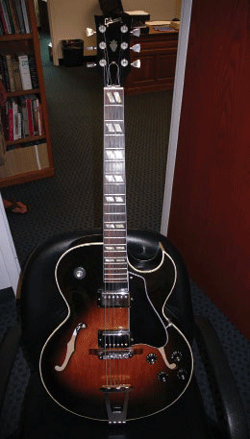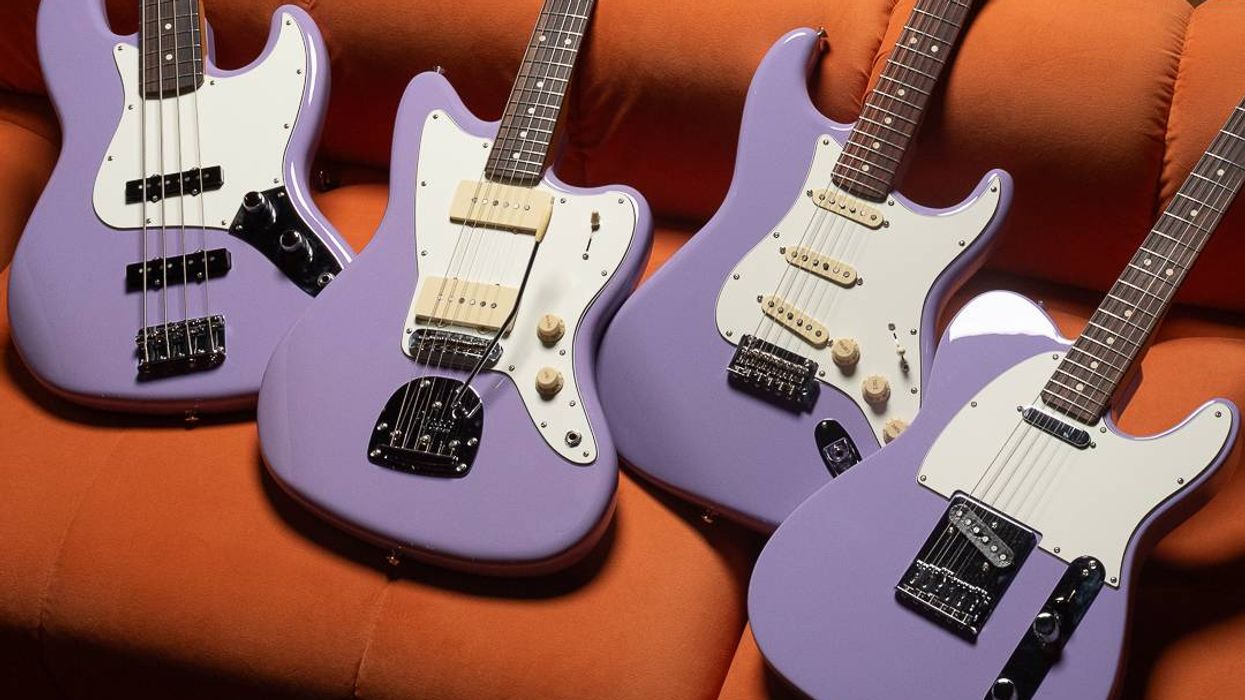Note: This is the second of a two-piece article. Part one—found in last month’s issue— featured the Fender Princeton Reverb. Both pieces were in our offices, so I was able to inspect them personally. Unfortunately, some of the information in this article cannot be seen in the pictures.
Hey Zach,
I bought this Gibson guitar and Fender amp new in the late 1970s or early 1980s and only played them a few times. A few years later, I gave the guitar and amp to my father, but he played them very little as well. My father passed away last winter and I found them when I was cleaning out his closets. I still don’t play so I’d like to sell them, and I’m curious as to exactly what I have and how much they are worth. Can you help?
Jim in Forest Lake, MN
Hey Jim,
It’s always a treat when players bring in gear to our office for evaluations, appraisals and identification, and I especially enjoy it when the instruments are this clean! Let me start by telling you that aside from a good cleaning and new strings, this guitar needs nothing to become a full-time player.
Your guitar is a Gibson ES-175D produced in 1980. In 1977, Gibson finally standardized their serialization system with an eight-digit format that reads like this: YDDDYNNN. The serial number on your guitar is 8150001X with “SECOND” stamped below it. The first and fifth digits [8, 0] indicate the last two numbers of the year your guitar was built: in this case, 1980. The second, third, and fourth digits [1,5,0] indicate the day of the year your guitar was built based on the Julian calendar [the 150th day of 1980 was May 29—keep in mind this was a leap year]. The last three digits are the production number from that day. During this time, Gibson had two factories open—the original in Kalamazoo, Mich., and a new one in Nashville, Tenn. Production numbers started at 001 each day in Kalamazoo and 501 each day in Nashville [this practice continued until 1984 when Kalamazoo closed]. Visit our website [guitars.bluebookinc.com] for more Gibson serialization information.
The “SECOND” stamped onto the back of your headstock underneath the serial number indicates that the guitar was shipped from the factory with some sort of finish blemish or other imperfection, and that it was sold at a discounted price with a full factory warranty. I’ve seen quite a few of these from the 1970s and early 1980s, and there is a lot of discussion amongst vintage guitar collectors as to whether or not this was a conspiracy to sell more guitars. I noticed a discoloration in the neck on the bass side that appears under the finish, which I assume is the blemish that probably warranted the “SECOND” designation.
The features of your guitar include a single sharp cutaway deep hollow maple body, two f-holes, three-ply top binding, single-ply back binding, set maple neck, 20-fret bound rosewood fingerboard with split parallelogram inlays, black headstock overlay with pearl logo and crown inlay, three-per-side tuners, rosewood-based Tune-o-matic bridge, trapeze tailpiece with three raised parallelograms, multi-ply raised pickguard, two humbucker pickups, four black knobs with silver insets [two volume, two tone], threeway pickup switch and chrome hardware. The guitar is 16.25 in. wide and has a scale length of 24.75 in. Available finishes at the time were Natural and Sunburst.
The ES-175 continues to be a popular guitar for Gibson, and has been in continuous production since 1949 (double pickup models first appeared in 1951). Since so many of these guitars are stamped “SECOND,” the designation hasn’t affected the value very much. This particular guitar has a few other minor finish blemishes, but other than that this guitar is near mint. In the vintage retail market, you should be able to get between $2250 and $2750. I played this beauty and found it very nice. Then again, it’s difficult to name a hollowbody Gibson that isn’t a treasure!
Zachary R. Fjestad
Zachary is the author of the Blue Book of Acoustic Guitars, Blue Book of Electric Guitars, and the Blue Book of Guitar Amplifiers. Questions can be submitted to:
Blue Book Publications
Attn: Guitar Trash or Treasure
8009 34th Ave. S. Ste #175
Minneapolis, MN 55425
800-877-4867
bluebookinc.com
guitars@bluebookinc.com
Hey Zach,
I bought this Gibson guitar and Fender amp new in the late 1970s or early 1980s and only played them a few times. A few years later, I gave the guitar and amp to my father, but he played them very little as well. My father passed away last winter and I found them when I was cleaning out his closets. I still don’t play so I’d like to sell them, and I’m curious as to exactly what I have and how much they are worth. Can you help?
Jim in Forest Lake, MN
Hey Jim,
It’s always a treat when players bring in gear to our office for evaluations, appraisals and identification, and I especially enjoy it when the instruments are this clean! Let me start by telling you that aside from a good cleaning and new strings, this guitar needs nothing to become a full-time player.
Your guitar is a Gibson ES-175D produced in 1980. In 1977, Gibson finally standardized their serialization system with an eight-digit format that reads like this: YDDDYNNN. The serial number on your guitar is 8150001X with “SECOND” stamped below it. The first and fifth digits [8, 0] indicate the last two numbers of the year your guitar was built: in this case, 1980. The second, third, and fourth digits [1,5,0] indicate the day of the year your guitar was built based on the Julian calendar [the 150th day of 1980 was May 29—keep in mind this was a leap year]. The last three digits are the production number from that day. During this time, Gibson had two factories open—the original in Kalamazoo, Mich., and a new one in Nashville, Tenn. Production numbers started at 001 each day in Kalamazoo and 501 each day in Nashville [this practice continued until 1984 when Kalamazoo closed]. Visit our website [guitars.bluebookinc.com] for more Gibson serialization information.
 A beautiful Gibson ES-175D in Vintage Sunburst |
The features of your guitar include a single sharp cutaway deep hollow maple body, two f-holes, three-ply top binding, single-ply back binding, set maple neck, 20-fret bound rosewood fingerboard with split parallelogram inlays, black headstock overlay with pearl logo and crown inlay, three-per-side tuners, rosewood-based Tune-o-matic bridge, trapeze tailpiece with three raised parallelograms, multi-ply raised pickguard, two humbucker pickups, four black knobs with silver insets [two volume, two tone], threeway pickup switch and chrome hardware. The guitar is 16.25 in. wide and has a scale length of 24.75 in. Available finishes at the time were Natural and Sunburst.
The ES-175 continues to be a popular guitar for Gibson, and has been in continuous production since 1949 (double pickup models first appeared in 1951). Since so many of these guitars are stamped “SECOND,” the designation hasn’t affected the value very much. This particular guitar has a few other minor finish blemishes, but other than that this guitar is near mint. In the vintage retail market, you should be able to get between $2250 and $2750. I played this beauty and found it very nice. Then again, it’s difficult to name a hollowbody Gibson that isn’t a treasure!
Zachary R. Fjestad
Zachary is the author of the Blue Book of Acoustic Guitars, Blue Book of Electric Guitars, and the Blue Book of Guitar Amplifiers. Questions can be submitted to:
Blue Book Publications
Attn: Guitar Trash or Treasure
8009 34th Ave. S. Ste #175
Minneapolis, MN 55425
800-877-4867
bluebookinc.com
guitars@bluebookinc.com








![Rig Rundown: John 5 [2026]](https://www.premierguitar.com/media-library/youtube.jpg?id=62681883&width=1245&height=700&quality=70&coordinates=0%2C45%2C0%2C45)








